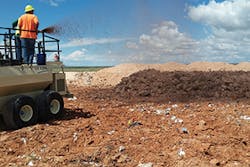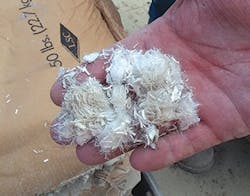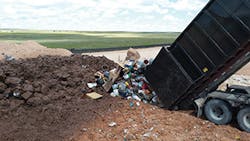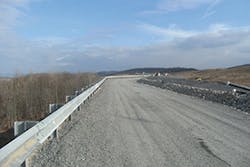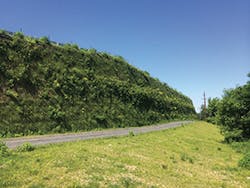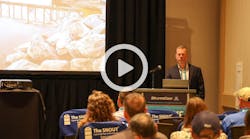Managing Daily Cover and Drainage at MSW Landfill Sites
Today’s municipal solid waste (MSW) landfills are much more than places to dump household trash. They’re engineered facilities that are designed to hold and isolate the trash from the environment and are governed by both federal and state regulations.
Landfill designers and operators face two main challenges to the integrity of their landfills. One occurs on the face of landfills, where they have to control windblown litter; landfill gases; rodents, birds, and insects that scavenge and transmit disease; and potential fires.
The other challenge occurs because of water within the landfill. Precipitation penetrates the surface on landfills where the daily cover is permeable. Moisture may exist in the waste, and groundwater may come in contact with the waste. The water in the landfill ponds or moves horizontally and through side seeps. As it comes into contact with the trash, it picks up contaminants. If the contaminated water, or leachate, seeps out of the landfill, it can contaminate both surface waters and groundwater.
Hydromulch mixes typically contain a combination of wood fibers, polyester and/or cotton textile fibers, shredded paper, and a polymer to make the hydromulch fluffy, sticky, and more durable.
Both these challenges must be handled without creating a threat to human health or to the environment.
To control the problems on the surface of landfills, managers use daily cover on the landfill cell, the specific area of the landfill where waste is dumped and compacted. Traditionally daily cover has consisted of a 6-inch layer of soil, either from onsite or imported by dump trucks. When compacted, the soil may be relatively impermeable.
Alternative materials for daily cover (ADC) are permitted by many states as long as they perform to the same standard as 6 inches of soil. These materials often save a combination of airspace, money, and time.
Permeable ADC includes hydromulch and waste products such as shredded tires, glass aggregate mixed with soil or shredded tires, and foundry sand. Because these covers are permeable, water passes through the landfill cell. Without proper management, leachate may become a major problem. Impermeable daily cover materials include tarps, geosynthetic films, and sprayed foams.
Leachate is a more complex problem. In landfills that contain organic matter such as food scraps, water begins a chain reaction. Along with the oxygen that remains in the landfill after compaction, water helps bacteria and fungi decompose the organic matter, producing gases such as methane and carbon dioxide.
Leachate is typically a cloudy black, yellow, or orange liquid and has a sharp, biting smell or a strong smell of rotten eggs. When it reaches bodies of water, decomposition increases and oxygen decreases. The lack of oxygen kills vegetation and aquatic life, which decompose, leading to further depletion of the oxygen levels and further loss of aquatic life.
Leachate may also contain a high concentration of toxic substances and hazardous organic chemicals. The substances may include suspended solids; inorganic macro components such as sulfates, chloride, iron, aluminum, zinc, and ammonia; heavy metals; and organic compounds such as PCBs and dioxins.
Landfill engineers often design a drainage system to contain and remove the leachate within the landfill. A drainage layer of sand or gravel or a geonet collects the leachate and allows it to drain by gravity to the pipe system. There may be one pipe or a network of them that conveys the leachate to sumps that transport it to a collection or treatment location. These pipes lie on a liner at the bottom of the landfill.
EPA and some states specify design standards for bottom liners, which must cover the entire bottom and sides of the landfill. The liner forms a barrier to the leachate and helps prevent the escape of landfill gases.
Liners have either two separate layers or one composite layer. Liners with two layers consist of a flexible, impermeable geomembrane, typically constructed of high-density polyethylene (HDPE), above a 2-foot layer of compacted clay. Composite liners, called geosynthetic clay liners (GCLs), are manufactured as a single mat where a geomembrane incorporates a layer of compacted clay soil. The liner lies on structural fill or bedrock.
The final cover, or cap, on a closed landfill seals the waste from the air and reduces the amount of water infiltrating into the landfill. EPA and some states specify design standards for final covers and for providing for their long-term care.
The cap generally consists of several sloped layers over the compacted landfill. The first is an impermeable layer of either 18 inches of clay or one or more geosynthetic liners. These prevent excess precipitation from entering the landfill and help prevent the escape of landfill gases.
Next is a drainage layer of sand or gravel, or a geonet to promote rain runoff. A geotextile fabric may be placed on top of this layer to separate it from the top layer: 6 inches of topsoil.
The topsoil retains moisture and provides nutrients to the vegetation—often native grasses and shrubs—that is planted to stabilize the underlying layers of the cover and to be visually pleasing. Often the closed landfill is used as open space—for example, as a public park.
According to EPA, closed landfills must be monitored and maintained, and the groundwater must be monitored for 30 years to ensure that waste is not escaping.
The first profile below, of the Estancia Valley Regional Landfill in New Mexico, shows how one method of ADC, hydromulch, can be very successful in covering an MSW landfill in terms of saving money, time, and airspace. It also shows many potential uses for hydromulch as cover in landfills.
The second profile shows a large landfill expansion project in Bethlehem, PA. The use of mechanically stabilized earth (MSE) walls created 2.5 acres of additional airspace in the footprint of the existing landfill.
A new load of trash being dumped on the previous day’s daily cover
Estancia Valley Regional Landfill
Andy Miller stepped into his new job as manager of landfill operations at the Estancia Valley Regional Landfill in May 2016.
“I inherited a fantastic operation,” says Miller. “It was well run and it had great people. But I needed to replace one million dollars of equipment: a scraper to move soil. I also had received a notice of violation for windblown trash.”
The MSW landfill is in Torrance County, NM, one of the most productive agricultural counties in the US. It serves the county and as far east and north as Santa Rosa and Las Vegas, NM, approximately 100 miles away. The area receives only 10 to 12 inches of rain per year.
The MSW cell at the landfill is approximately 10 acres and receives some 60 tons of trash per day, or 1,800 tons per month.
Miller had worked with hydroseeding machines before and wanted one that had the capacity and the horsepower the landfill required, as well as a mechanical mixer. He purchased a Finn LF120 Landfill Machine for $60,000.
Because of the cost of the machine, the state and Miller’s organization required him to put the request out to bid. Finn met the specifications and was also the low bidder.
“The hydromulcher really makes good sense,” he says. “I’m very happy with it. It does everything I was expecting it to do.”
State and federal regulations require MSW landfills to apply cover material at the end of each day. Traditionally, 6 inches of soil has been used as daily cover to any open face. New Mexico state law allows the use of ADC, including hydromulch, as long as it meets a set of ASTM specifications, which include requirements regarding flammability and odor control.
A handful of vendors provide ADC material that meets ASTM specs, Miller says. The mulch he uses usually contains a combination of wood fibers, polyester or cotton textile fibers, shredded paper, and a polymer to make the hydromulch fluffy, sticky, and more durable. The mulch is dyed brown to make it easy to see where it’s been sprayed.
Similar to soil cover, hydromulch lets some rainwater in; however, landfills in New Mexico are very dry and there’s very little decomposition. “This mulch is designed to protect the working face from exposure to people, animals, and fire,” says Miller.
There’s a cost associated with the supplies, he says, “but a million dollars worth of materials is going to go a long way. And I have one of the biggest machines available. I could use it to hydromulch a landfill 10 times my size. The hydromulcher will substitute for much of the soil that has to be moved. But soil still does need to be moved. As a substitute for the scraper, I’m getting a dump truck and an excavator for a few hundred-thousand dollars.”
The benefits of hydromulching come from multiple sources.
“In the landfill world, space is money,” says Miller. Realistically, applying 6 inches of soil as landfill cover every day requires more than 6 inches, because some of the soil infiltrates into the trash. Instead, he’s applying approximately one-quarter of an inch of hydromulch per day, leaving much more airspace for more trash, which provides additional income for the landfill.
“The landfill operates five days a week,” he says. “At a minimum, I’d be adding 30 inches of soil. In a week of using hydromulch, I’m adding slightly more than an inch.”
Hydromulching also saves time—which in turn saves money. What took two people about six hours of labor now takes one person about 30 minutes, he says.
He saves on costs for excavating soil or for purchasing, loading, and hauling offsite soil, as well as on costs for tipping and spreading soil from dump trucks. And, he no longer needs a scraper.
Miller also saves on fuel. Before he began hydromulching, the landfill’s vehicles burned 40 gallons of fuel a day. Now they use less than half a gallon a day.
“We can use the hydromulcher under any temperature conditions,” he says. “It gets very hot here, and there are long periods of freezing. When it’s freezing, we have to drain the machine or park it in a heated space. When it’s raining, we might mix a slightly thicker batch of hydromulch. When it’s windy, we place the machine to take advantage of wind direction.”
While the primary use of the LF120 is to apply ADC at the MSW cell, he also uses it to control erosion and windblown litter. Workers spray hydromulch when trucks are dumping loads of trash and throughout the property.
Miller has added Portland cement to the hydromulch to create a very durable, erosion resistant, one-quarter-inch-thick crust over an area that was excavated in preparation for a new MSW cell. “We shot it with cement several months ago,” he says. “It looks the same now as it did then.”
He’s already looking at the future, and it includes the Finn LF120.
“The potential is there,” he says. “In my region, some construction debris piles have been discovered to contain asbestos. We could add Portland cement to encapsulate them until proper disposal was arranged.”
He also has plans to make his own mulch. “One of the banes of landfills is C&D [construction and demolition] debris. We receive literally tons of wood, paper, and cardboard. I have this long-term vision that would be the ultimate in recycling: to grind them up and create my own hydromulch mix.”
Removing the wood portion would create more airspace in the cell, and he would use his mulch on the cell instead of purchasing mulch.
He’s also planning to add seed to the hydromulch instead of Portland cement. “Vegetation is a great method of erosion control,” he says. “We’ll use it to hydroseed our closed landfill cells and, I hope, to revegetate disturbed areas at illegal dump sites after they’ve been cleaned up. We have a composting area. We may use the machine to demonstrate erosion control with and without seed.”
Another plan is to market erosion control and hydroseeding services to other landfills and use his mulch for hydroseeding. He purchased a set of highway tires for the LF120 so he could transport the mulch to other sites.
“My first energies will be directed to my own landfill,” says Miller, “but my next efforts will be marketing.”
Bethlehem Landfill Expansion
When officials at IESI PA Bethlehem Landfill Corp. wanted to change stormwater drainage patterns and add capacity to their MSW landfill, they consulted Martin & Martin Inc., an engineering and planning firm based in Pennsylvania that specializes in solid waste management.
The first stages of the wall, which is approximately 2,000 feet long, a maximum of 44 feet high, and 31 feet thick
“They were looking to redirect stormwater runoff away from a sensitive watershed,” says Kevin Bodner, Martin & Martin’s vice president for field operations and the project manager for the expansion. “They also wanted to maximize the current permitted footprint capacity while looking several years down the road for potential expansion.”
After a geotechnical investigation that included several borings, Martin & Martin chose the solution: a MSE wall. MSE walls consist of a series of layers of compacted earth stabilized by layers of geogrid.
“MSE walls allow for a vertical boundary to extend the limits of the trash, which increases the capacity of landfills with minimal increase to their footprint,” says Bodner. “In this case, the wall also allowed us to ‘tip’ the final disposal area perimeter in order to direct runoff to the east and south rather than to the north or west.”
The completed project
Martin & Martin chose Tensar’s ADD³ Capacity Improvement Systems, which uses two geogrids from Tensar Corp. in Alpharetta, GA. Tensar’s Uniaxial (UX) geogrid and Biaxial (BX1120) geogrid stabilize the layers of compacted earth that form the wall and the backfill, as well as the liner system above the landfill.
“We’d done a landfill expansion project on another site with Tensar,” notes Bodner. “We have a very positive relationship with the folks at Tensar, and the client’s experience with Tensar was very positive.”
Tensar’s Uniaxial geogrids are manufactured from high-density polyethylene and engineered to have high reliability and little settling. They’re highly resistant to installation damage as well as to long-term chemical and biological degradation, and can be used with a variety of backfill materials, including recycled concrete.
The Biaxial geogrids are blends of polypropylene, copolymers, and additives. They resist high dynamic loads over the short term and moderate loads over longer time periods.
Tensar designed the wall with input from Martin & Martin. “We did a lot of work on this site with Doug Brown of Tensar,” says Bodner. “He was very helpful.”
The wall added 2.5 acres of new, usable lined footprint as well as extensive overtopping to the existing 113-acre site.
“Before the wall was built, all the stormwater went around the west side of the property,” says Bodner. “Now the wall sends the water around the landfill to the east and south.” This opens the possibility of expanding to the west.
The landfill is on an east-west hillside that inclines then declines steeply to the north in a rural/suburban area in central Pennsylvania, not far from New York City. The landfill area is part of the Reading Prong, which consists of metamorphic granitic gneiss above sedimentary rock.
The total area of the face of the wall is 45,000 square feet. Its maximum height is 44 feet, and its maximum thickness is approximately 31 feet. The wall extends part way around the landfill, within the permitted footprint of the landfill, with a length of approximately 2,000 feet.
The wall was built in two sections. Latona Trucking of Pittston, PA, was the general contractor for the first, and NAPA Development Corp. of Windgap, PA, was the contractor for the second. Both contractors were responsible for excavating the existing soils to the design base grades to ensure that the proper embedment grade for the wall base was achieved. They also placed and compacted the fill for the wall construction.
The first section was approximately 1,200-feet long and was finished in 2011. The backfill, approximately 30,000 to 40,000 cubic yards of a rock and sand mix, came from onsite. The remaining 800 feet was completed in 2016. For this phase, the landfill purchased approximately 12,000 cubic yards of aggregate.
The face of the wall consists of a stack of welded L-shaped wire baskets 18-inches high embedded in backfill. The baskets ensure that the layers are constructed at the proper setback, a maximum of 3 inches. They also act as guides in placing the geogrid.
Pinnacle Design/Build Group of Cumming, GA, installed the baskets, geogrid, and erosion control blanket for both sections. “Joe Harris, the owner of Pinnacle, was fantastic to work with,” notes Bodner.
“The specs for stacking the baskets were relative to the grain size of the soil, the rock for the fill, and the moisture and compaction that need to be achieved, all of which are tested by the CQA [construction quality assurance] inspector,” he says.
For each row, or lift, Pinnacle placed a row of baskets along the footprint of the landfill. Workers filled the baskets with topsoil and a seed mix approved by a landscape architect. They placed backfill behind the baskets and compacted the layer with small compaction equipment close to the face of the wall and larger compaction equipment 5 feet from the face. The CQA inspector made sure each lift of soil was compacted without damaging the geogrid.
On the layer of backfill, they placed Tensar’s Uniaxial geogrid perpendicular to the face per Tensar’s design. They placed the Biaxial geogrid and SC150 erosion control blanket on the face of the wall to hold in the seed and the topsoil in the baskets.
The geogrid layers that extend to the wall face tie the baskets to the wall. “The geogrid is the glue,” says Bodner.
Pinnacle crews repeated this process until they achieved the final design top grade. Once the wall was constructed, the general contractor graded the disposal area behind the wall for construction of the liner system.
The liner system above the existing landfill consists of, from bottom to top, a 6-inch layer of a compacted clayey soil subbase; a 60-mil textured HDPE geomembrane from Agru America; a composite geonet from SKAPS Industries; a GSL from Agru America; another textured HDPE geomembrane from Agru America; and another layer of the composite geonet from SKAPS Industries.
On top of the liner system, the contractor lay an 18-inch layer of aggregate. Under the observation of the CQA inspector, the contractor carefully placed HDPE leachate collection piping. A perimeter road was then constructed on the top of the wall for access to the landfill.
“Both phases went well,” says Bodner. “Obviously with the dry year we had in 2016, the second phase went real well. The contractor also gave the wall face a little dose of water during construction to help establish the vegetation.”
